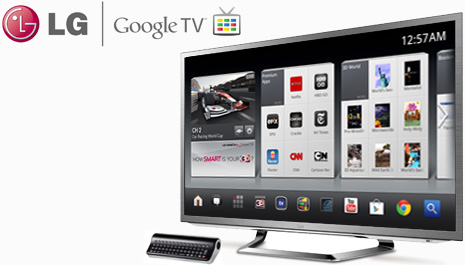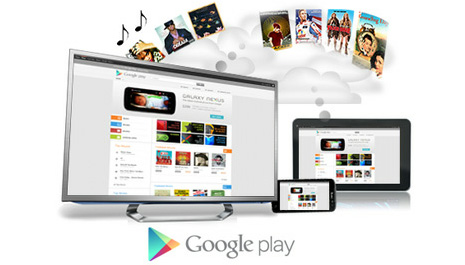Google’s struggling Google TV platform took a big step last October with the Android 3.0-powered version 2.0. It got another push with a June 6 “2.1.1” update that enables the viewing of movies rented through Google Play and extends YouTube movie viewing options.
 But the real kicker arrived in late May with the arrival of a Google TV television from LG Electronics — the first Google TV driven by a dual-core ARM processor. Samsung, Vizio, and others are expected to ship similar GoogleTV products following an Android 4.0 (“Ice Cream Sandwich”) update due in the third quarter. This means Google’s web/TV platform will be available from the four top LCD TV manufacturers. And Sony, which currently offers a TV and Blu-ray player, will release updated Google TV players later this year.
But the real kicker arrived in late May with the arrival of a Google TV television from LG Electronics — the first Google TV driven by a dual-core ARM processor. Samsung, Vizio, and others are expected to ship similar GoogleTV products following an Android 4.0 (“Ice Cream Sandwich”) update due in the third quarter. This means Google’s web/TV platform will be available from the four top LCD TV manufacturers. And Sony, which currently offers a TV and Blu-ray player, will release updated Google TV players later this year.
Most of these devices will be running on powerful ARM processors and an advanced ICS operating system capable of multiplayer game play that could compete with traditional gaming consoles. Such platforms will also help Google TV pursue a top goal in convergent TV shared by Apple, Microsoft, and others: enabling seamless streaming of video and games among TVs, laptops, and mobile devices.
ARM Processors, Affordable Options Boost Appeal
LG’s new ”LG47” is the first Google TV device powered by an ARM processor: LG’s new L9 chipset, based on a 1GHz, dual-core Cortex-A9 CPU. In January, Google announced that Google TV would use dual-core ARM processors. Along with the more stable and advanced Android builds, the faster chips should make the Google TV experience considerably more pleasurable and reliable. The new platform also provides new possibilities for cloud-based gaming. This should help Google and its partners compete with gaming consoles, which themselves are evolving into convergent TV products.
Also helping Google TV’s chances in the mass market is the development of simpler, more affordable products. Those who balk at LG47’s $1,699 pricetag are looking forward to an ARM-based Vizio VAP430 Stream Player, due this summer for $99 on the Google TV platform. The device should fill the role of Logitech’s affordable, but discontinued Revue set-top.
Taiwan-based Honeywld Technology’s latest “PowerZest” media player is also affordable, with an expected price of $100. It runs on Android 4.0, and includes an unofficial, customized version of Google TV, according to IDG News. Due to ship to OEMs in July, the box adopts Marvell’s 1.2GHz, dual-core Armada 1500 HD Media processor.
Future in Media Sharing and Cloud Services
The PowerZest box is said to enable TVs to play movies streamed from Android devices, a feature that may well appear in Google’s official Android 4.0 build for Google TV. Such multiple-screen media sharing and streaming features represent a hot trend in convergent TV products, along with related cloud services.
 In late April, LG announced an LG Cloud service that enables media sharing between Android smartphones, PCs, and LG TVs . Samsung had been expected to follow with the announcement of a similar S-Cloud service linked to its Galaxy S III Android smartphone.
In late April, LG announced an LG Cloud service that enables media sharing between Android smartphones, PCs, and LG TVs . Samsung had been expected to follow with the announcement of a similar S-Cloud service linked to its Galaxy S III Android smartphone.
Earlier this year, LG announced a partnership to bring Gaikai’s cloud gaming service to its Cinema 3D series Smart TVs, including the Google TV equipped LG47. Last week at the E3 show, LG unveiled a similar cloud gaming partnership with OnLive, demonstrating multiplayer games played on the LG47. Also at E3, Samsung unveiled a Gaikei-based Smart TV Cloud Gaming service for some of its Smart TV systems.
The TV manufacturers aren’t alone in focusing on a multiple-screen strategy. A rumored Apple TV update, complete with a debut SDK, is expected to feature seamless sharing of media between TVs, computers, and mobile devices. The update, which had been expected to make a showing at this week’s Apple developer conference, remains under wraps.
Microsoft, which a decade ago saw its WebTV experiment go down in flames, is onto something similar with a “SmartGlass” app announced last week. The app will enable media sharing between its Xbox console and Windows 8 phones and tablets. SmartGlass even enables video and games to be started on one device and finished on another.
Perhaps in response to SmartGlass, or as a preview of the ICS version of Google TV, the Google TV blog on June 8 profiled a Google TV-compatible Videon app called aVia Media Player. The Android app is said to enable easier sharing of media between Google TV, Android devices, and computers.
More Competition from Linux and Android Boxes
While Google aims to stay ahead of these trends, both Google TV and Apple TV face competition from a growing number of simpler Linux- and Android-based IPTV boxes, such as the popular Linux-based Roku devices. Lately, Roku and others have been shrinking these media players onto tiny sticks that plug into a TV’s HDMI slot. Such devices lack advanced Google TV features such as picture-in-picture and unified search of Internet and TV content, but they deliver simple, affordable Internet services on the TV.
It could be that basic media players, will fulfill consumers desire for web/TV/mobile convergence. Google and Apple, however, are betting that a more robust offering can find a role. Now that Google owns Motorola, a world leader in set-top manufacturing, the company should have more tools available to give Google TV a fighting chance.


